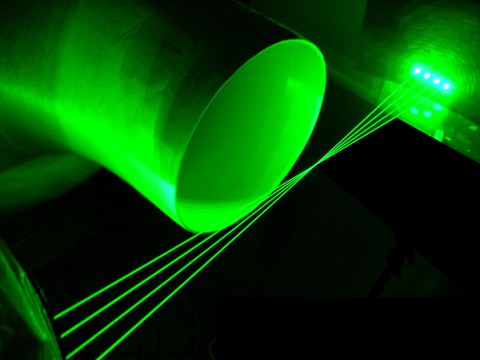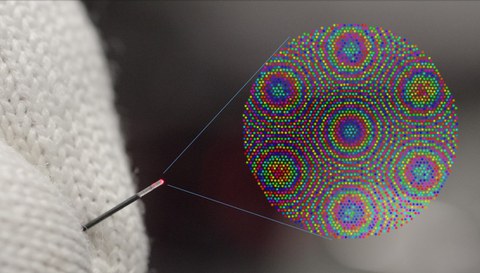Areas of research
The laboratory is divided into four areas of research:
A) Optical systems for measuring complex flows

Flow metrology: Use of frequency-modulated laser beams for high-resolution velocity measurements.
Flow processes in nature and technology include a variety of exciting phenomena. The MST investigates and realizes flow measurement methods, which can open new windows for flow studies. Examples are new methods in microfluidics (3D particle image velocimetry), precise measurements of shear or boundary layer flows, the contactless, seeding-free measurements of injection processes, aeroacoustics and combustion techniques.
B) Adaptive computational endoscopic systems
Existing microendoscopic systems are limited in the minimal diameter and to 2D imaging. Novel lensless 3D endoscopes with diameters below 500 µm are being investigated, realized together with partners from industry and applied with research partners at MST for instance in Optogenetics and tumor diagnostics.
The systems are based on holography for self-calibration, adaptive optics, fs-Lasers, speckle correlation techniques and digital signal processing based on deep learning.
C) Ultrasound based methods for the investigation of multi-dimensional flows of opaque fluids.
In a variety of industrial applications flows of liquid metals or semiconductors play a central role. Magnetic fields are used to mix liquids in order to improve the crystal growth (magneto-hydrodynamics, MHD). Model experiments with low-melting metals are important for understanding the flow phenomena. The MST aims to realize novel 3D ultrasound measurement systems with up to 225 transducer elements. Compression and streaming of measurement data enables long experiment durations, fulfilling the requirements of MHD. Along with numerical simulation the crystal growth process of silicon is investigated, to improving the growth and the quality of solar cells.
Expertise of the ultrasound group:
- Big Data (computational ultrasonic imaging)
- Real-Time Systems / Wireless Communication
- Image and Signal Processing Technique
- FPGA (compression of a data stream of 1.2 GB/s by a factor of 10)
- 4D Visualization of Flows
- Condition Monitoring of Technical Processes
D) Adaptive laser systems for biomedicine.
Distortions during the propagation of light can degrade optical measurements dramatically or even completely prevent. Examples are fluctuating surfaces of multi-phase fluids or light scattering biological tissue. With the availability of modern adaptive optics, e.g. deformable mirrors, MEMS and liquid crystal modulators, it is possible to correct such distortions. The MST is exploring methods and control strategies, which allow measurements through distorting interfaces and in biological tissue with deep penetration.
E) Information transmission through multimode fibers
Topic:
Advances in fiber-optic systems enable data throughput to double every nine months, which is crucial for the advancement of internet. To cope with this continued exponential growth as Keck´s law, new fiber-optic communication systems must be developed. Unlike current single-mode fibers, multimode fibers have significant potential through spatial division multiplexing (SDM). However, there are challenging scattering effects in MMFs such as modal crosstalk leading to channel interference. A smart (De)-Multiplexer using AI was realized for communication exploiting SDM. Physics-informed deep learning enables to correct the scattering, resulting in advancing security and data rate. Control of lateral phase of structured light promises advances in classical and quantum communication with entanglement swapping.
“Multimode Optical Interconnects on Silicon Interposer Enable Confidential Hardware-to-Hardware Communication”, Sensors, 2023
“AI-driven projection tomography with multicore fibre-optic cell rotation”. Nature Communications, 15, (2024)
“Securing Data in Multimode Fibers by Exploiting Mode-Dependent Light Propagation Effects”, Research, (2023)
“Intensity-only Mode Decomposition on Multimode Fibers using a Densely Connected Convolutional Network”, IEEE/OSA Journal of Lightwave Technology, (2021)
Head of the group:
Juergen Czarske grew up on a farm of 20 hectares in the small village of Garbek, Schleswig-Holstein. He graduate from high school with distinctions. Electrical engineering and physics were studied at the Leibniz University until 1991, supported by scholarship of Siemens AG. With summa cum laude the doctoral degree was achieved in 1995. From 1995 to 2004 he worked at the Laser Zentrum Hannover, most recently as head of the measurement technology department. From 1996 to 2001 he has conducted short-term missions at research institutions in Japan and the United States of America. After completing his habilitation in the field of laser measurement technology in 2003, he has been a C4 professor at the Faculty of Electrical and Computer Engineering at the TU Dresden since 2004. Prof Czarske is Director of the Institute of Circuits and Systems, since 2016, and of the Center Biomedical Computational Laser Systems (BIOLAS), since 2019. He is Elected Member of Scientific Society for Laser Technology (WLT e.V.), Erlangen, since 2017, and Advisor of the OPTICA-SPIE-Student Chapter of TU Dresden. In 2022 he was selected as outstanding editor for Light: Advanced Manufacturing (LAM) of Nature Publishing, China. Since 2023 Prof. Czarske is member of editorial board of Light: Science and Applications.

